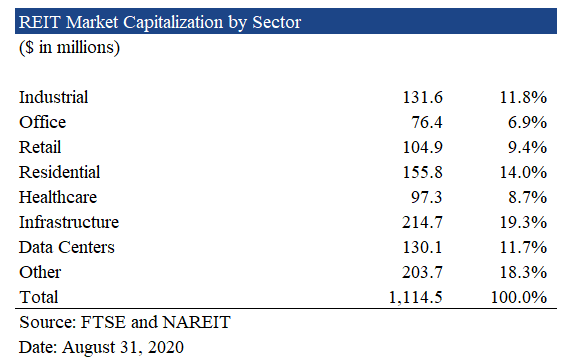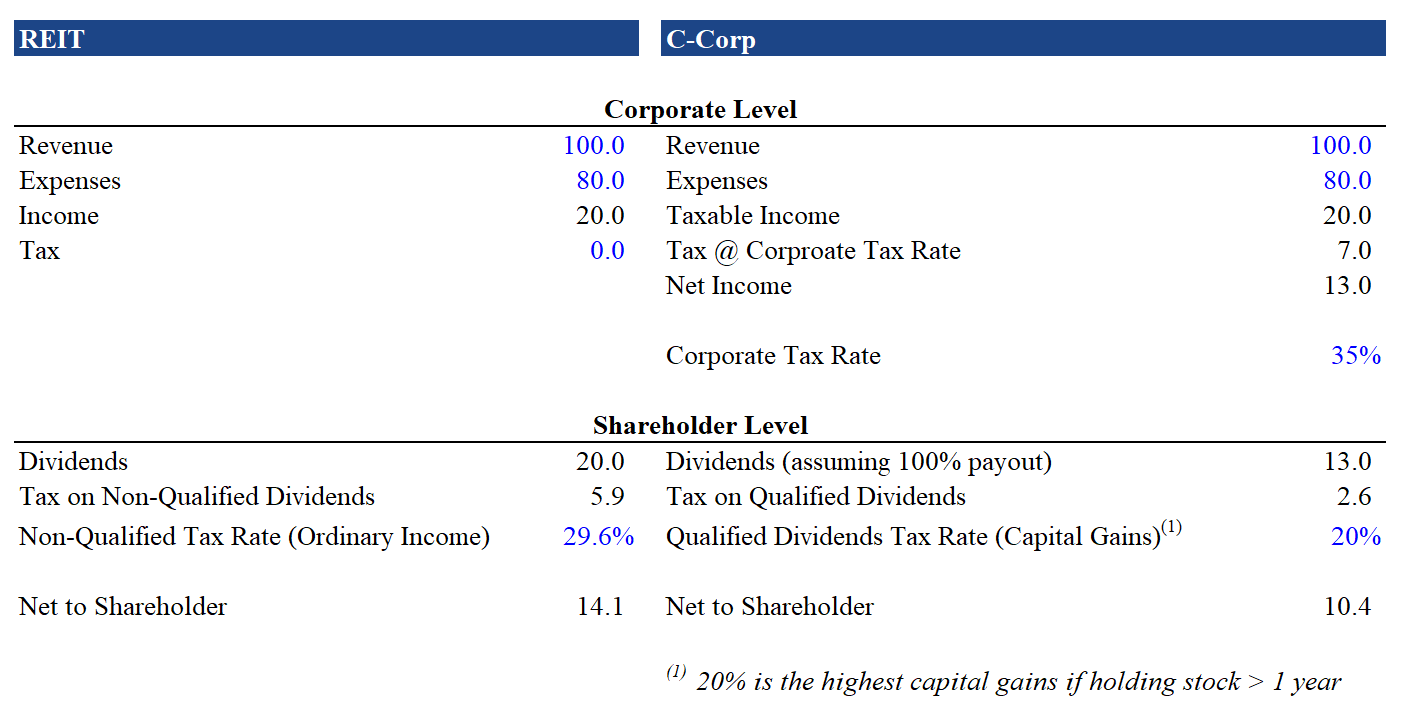- What is a REIT?
- How Does a REIT Work?
- Why Invest in REITs?
- What are the Historical Returns on REITs?
- What are the Largest REITs?
- What are the Tax Advantages of REITs?
- What are REIT Dividends?
- REIT vs. C-Corp: What is the Difference?
- How Does a Company Qualify as a REIT?
- What are the Different Types of REITs?
- How to Analyze REITs?
- What are the Key REIT Metrics?
- How to Build a REIT Model in Excel
- What are the REIT Valuation Methods?
- What are the Other Types of Real Estate Companies?
What is a REIT?
A Real Estate Investment Trust (REIT) is a company that owns a portfolio of properties across a range of sectors such as offices, retail, apartments, hospitals, and hotels.
REITs actively invest in the properties themselves, generating income primarily through the collection of rent from tenants.

How Does a REIT Work?
REITs can invest in all property types, although most specialize in specific property types. There are around 160 US public REITs with a combined market cap of $1 trillion (Globally, there are 300 REITs with a market cap of $3 trillion).
Most REITs are publicly traded, which enables investors to gain access to a diversified collection of income-producing real estate similar to investing in mutual funds. Unlike regular companies that can hold on to their profits, REITs must distribute at least 90% of their profits every year back to shareholders in the form of dividends.
As a result of the dividend requirement, the dividend yield on REIT stocks is above 4% – significantly higher than the 1.6% dividend yield for the S&P 500 overall.
In addition to facilitating diversification and high dividend yield, the other major benefit of REITs over other forms of real estate investment is the tax advantages.

Why Invest in REITs?
REITs are a tax-efficient, diversified alternative to direct real estate ownership and investment.
Rather than having to buy and maintain actual physical real estate properties, investors can simply own REIT shares, which are backed by physical assets managed by the REIT.
| Feature | REITs | Real Estate |
|---|---|---|
| Liquidity (Easy to buy and sell) | Advantage | |
| Low capital intensity (Doesn’t require a lot of capital to invest upfront) | Advantage | |
| Diversification (Easy to invest in multiple property types across geographies) | Advantage | |
| Control (Influence on management and strategy) | Advantage |
What are the Historical Returns on REITs?
Contrasting REIT vs Real Estate returns is a little more complicated.
REITs have generated 10% in annualized returns over the long run (including the last 10 years).
Meanwhile, real estate assets have grown at 2-3% annually, seemingly giving an advantage to REITs. However, this is not an apples-to-apples comparison.
A huge accelerator of returns is leverage: The average debt / total value for Equity REITs is 37.0% as of 2020 (Source: NAREIT).
Meanwhile, direct real estate investment can range widely, but at the high end, investors can secure debt upwards of 80% of the total property value, which all else equal amplifies returns (and risk) significantly.
The Wharton Online and Wall Street Prep Real Estate Investing & Analysis Certificate Program
Level up your real estate investing career. Enrollment is open for the Feb. 10 - Apr. 6 Wharton Certificate Program cohort.
Enroll TodayWhat are the Largest REITs?
Below is a list of the top 20 largest public REITs in the world, by market cap:
| Ticker | Name | Market Capitalization ($mm) |
|---|---|---|
| AMT | American Tower Corp. | $10,7318 |
| PLD | Prologis, Inc. | $73,278 |
| CCI | Crown Castle International Corp. | $69,955 |
| SPG | Simon Property Group, Inc. | $42,863 |
| DLR | Digital Realty Trust, Inc. | $38,576 |
| PSA | Public Storage | $38,346 |
| WELL | Welltower, Inc. | $22,830 |
| AVB | AvalonBay Communities, Inc. | $20,999 |
| O | Realty Income Corp. | $20,919 |
| WY | Weyerhaeuser Co. | $20,686 |
| EQR | Equity Residential | $20,331 |
| ARE | Alexandria Real Estate Equities, Inc. | $20,071 |
| HCP | Healthpeak Properties, Inc. | $17,708 |
| VTR | Ventas, Inc. | $15,554 |
| EXR | Extra Space Storage, Inc. | $14,546 |
| SUI | Sun Communities, Inc. | $14,341 |
| DRE | Duke Realty Corp. | $13,703 |
| ESS | Essex Property Trust, Inc. | $13,529 |
| MAA | Mid-America Apartment Communities, Inc. | $13,172 |
| BXP | Boston Properties, Inc. | $12,528 |
What are the Tax Advantages of REITs?
Entities qualifying for REIT status under the tax code receive preferential tax treatment: The income generated by REITs is not taxed on the corporate level and is instead taxed only on the individual shareholder level.
Specifically, REIT profits pass through – untaxed –to shareholders via dividends.
This is a tax advantage over C-corporations, which are taxed twice – first, on the corporate level, and then a second time on the individual level via a tax on dividends.
In order to qualify for this tax status, REITs must comply with certain requirements, the biggest one being that REITs are required to distribute nearly all profits (at least 90%) as dividends
What are REIT Dividends?
REIT dividends are cash distributions to REIT shareholders. REITs distribute almost all of their profits as dividends.
REIT dividends are typically “non-qualified” dividends, meaning they are taxed at ordinary income tax rates (up to 29.6%1), as opposed to the lower capital gains (up to 20%) on the shareholder level.
That doesn’t sound so great but remember that this is the only tax the investor pays because REITs entirely avoid a corporate-level tax.
In contrast, in a C-corp, there is a corporate-level tax (up to 21%), followed by a second tax on any dividends distributed to shareholders (albeit at the lower capital gains rate of 20% because C-corp dividends are typically “qualified dividends”).
REIT vs. C-Corp: What is the Difference?
This simple illustration shows the basic difference between the single pass-through taxation of a REIT and the double taxation of a C-corp.
Note, however, the following model is a simplification of a rather complex topic.
REIT tax rules can get quite complicated, especially if tax breaks for depreciation are brought into the picture, which can further increase the tax advantages of REITs.

How Does a Company Qualify as a REIT?
In order to qualify and be formally recognized as a REIT, the following requirements must be met (and abided by):
| Requirement | Description |
|---|---|
| Dividends | At least 90% of taxable income must be distributed as a dividend
|
| Gross income
(annual test) |
At least 75%of gross income must come from
At least 95% of gross income must come from
|
| Assets | At least 75% of assets must be Real estate, mortgages, equity in other REITs, cash, and government securities |
| Subsidiaries |
|
| Shareholders |
|
| Entity |
|
What are the Different Types of REITs?
Equity vs. Mortgage REITs
Most REITs directly own the real estate and are called equity REITs. However, a few REITs simply own mortgages (Mortgage REITs) and collect income (interest income) from the mortgages.
| REIT Type | Description |
|---|---|
| Equity
90% of total |
Equity REITs acquire, develop, and then operate its own properties, unlike other real estate companies which tend to resell once developed |
| Mortgage
10% of total |
Purchase debt (real estate loans and mortgage-backed securities) |
Internal vs. External Management
REITs can be internally or externally managed
| REIT Type | Description |
|---|---|
| Internal management |
|
| External management |
|
How to Analyze REITs?
When valuing REITs, investors look at both traditional profit metrics such as EBITDA, as well as real estate and REIT-specific metrics, including:
- Net Operating Income (“NOI”)
- Funds from Operations (“FFO”)
- Adjusted Funds from Operations (“AFFO”)
- Capitalization Rate (“Cap Rate”)
What are the Key REIT Metrics?
Net Operating Income (NOI)
Net operating income, or “NOI”, is the most important profit measure in real estate.
NOI strives to isolate to core operating profits of real estate assets, so as to avoid muddying the waters with non-operating items such as corporate overhead and major non-cash items like depreciation.
In a sense, NOI is similar to EBITDA, but with even more add-backs to really focus on pure operating income generated by the properties.
Thus, NOI captures profitability before any depreciation, interest, taxes, corporate-level SG&A expenses, capital expenditures, or financing payments
Learn More → Net Operating Income (NOI)
Funds from Operations (FFO)
While NOI is a useful profit measure for analyzing real estate down to the property level, FFO is a real estate-specific metric for cash generated from operations.
FFO is an attempt to reconcile accounting (GAAP) net income to a consistent measure of profit specifically tailored for analysis of REITs. In fact, most REITs provide FFO reconciliations in their filings.
While often misunderstood, FFO is NOT actually designed to be a measure of cash flow because the formula excludes working capital, capital expenditures (Capex), and other cash flow adjustments
Learn More → Funds from Operations (FFO)
Adjusted FFO (or Cash Available for Distribution)
Over time, analysts and REITs themselves have begun using slightly altered versions of FFO, generally called “adjusted FFO” or AFFO.
The reason for this is that FFO included things like nonrecurring items and notably omitted key outflows like capital expenditures.
While there remains some inconsistency across how these are calculated, the most common calculation is:
Note: The adjusted funds from operations (AFFO) is also known as cash available for distribution or “CAD”.
Learn More → Adjusted FFO
Cap Rate (Capitalization Rate)
The cap rate, along with NOI are arguably the most important metrics in real estate. Unlike NOI or FFO, however so far, the cap rate is not actually a measure of profit, but rather a yield measure.
It measures the real estate property’s operating profit as a % of the property’s value. If you’re familiar with EV/ EBITDA multiples, the closest thing to a cap rate is an inverse EBITDA multiple.
Cap rates are the primary shorthand by which different real estate properties are compared by investors. For example a property with a 10% cap rate provides a better yield than a comparable property with a 7% cap rate.
Capitalization Rate Calculation Example
A property with an asking price of $1m and NOI of $125k will have a $125k / $1 m = 12.5% cap rate
As we’ve noted, cap rates are simply the inverse of a traditional valuation multiples like EV/EBITDA.
What Factors Influence the Cap Rate?
Just as with traditional multiples, there are many variables that can distort the comparison of properties using this metric, including:
- Timing of NOI (LTM or forward)
- Growth rates
- Returns on capital
- Cost of capital of properties (or REITs) being compared
However, in real estate, it is much easier to find comparable properties (with therefore similar growth, returns, and cost of capital profiles), which mutes the problems described above.
Learn More → Cap Rate
How to Build a REIT Model in Excel
A REIT model will first forecast the financial statements and then apply the valuation methodologies discussed above to arrive at an investment thesis.
The key challenges in modeling REITs include modeling individual (same-store properties, acquisitions, developments, and dispositions) using the appropriate drivers and occupancy rate assumptions: Obviously mature properties with stable occupancy rates will have a different forecast profile than properties under development.
A second challenge is working with a real company’s financial statements. This requires digging into a REIT’s financial statements and ensuring consistent and logical modeling of REIT-specific metrics and ratios like funds from operations (FFO) and adjusted funds from operations (AFFO / CAD).
What are the REIT Valuation Methods?
So, how can the value of a REIT be determined?
In practice, analysts primarily value REITs using the following four approaches:
- Net Asset Value (“NAV”)
- Discounted Cash Flow (“DCF”)
- Dividend Discount Model (“DDM”)
- Multiples and Cap Rates
The most common of these approaches is the NAV and DDM due to the unique features of REITs.
Learn More → REIT Valuation Methods
What are the Other Types of Real Estate Companies?
There are other types of companies in real estate, most notably real estate private equity firms, as well as Real Estate Investment Management firms and REOCs, all with different characteristics and considerations.
The biggest difference between REITs and these other real estate companies is that REITs are publicly traded and report earnings quarterly.
From a strategy perspective, REITs tend to have a much lower risk tolerance than private real estate investment firms, which results in REITs’ portfolios consisting of primarily core assets (meaning more stable, lower cap rates), an aversion to redevelopment and development, and much less acquisition and disposition activity. Asset management roles are featured prevalently at most REITs.
1 The top marginal tax rate on ordinary income is 37% but REITs get a 20% deduction, dropping the rate down to 29.6%






